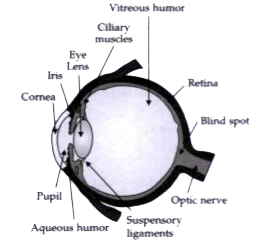Explain the structure and functioning of human eye. How are we able to see nearby as well as distant objects?
Text Solution
Structure of human eye : The human eye has following main parts:

(i) Cornea : Human eye is spherical in shape. It has tough white coat which protects the interior of the eye. The front portion of this coat is transparent and is called cornea.
(ii) Iris : This is a dark muscular structure behind the cornea. Unique colour of a person.s eye is because of colour of iris.
(iii) Pupil : The small opening in the Iris is called pupil. Iris controls the size of the pupil and thus controls the amount of light entering the eye. Light enters the eye through pupil.
(iv) Lens : It is thicker at the middle and is trade of transparent material. It focuses the light on the back of the eye, called retina.
(v) Retina : The back of the eye is called retina. It works like a screen, on which image is formed.
(vi) Rods and cones function as photo-receptors in the retina of the eye, turning visible light into neuronal signals, which are sent to the brain. This process is called transduction. These nerve cells are connected to optic nerve.
Formation of Image in Eye: Light rays enter the eye through pupil and pass through lens. Lens focuses light rays on retina. Real, inverted and smaller image is formed on retina. Optie nerve carries the message to the brain. The brain interprets the message and we get the sense of vision.
We are able to see nearby as well as distant objects due to the eye.s ability to adjust its focal length which is known as power of accommodation, Relaxation of muscles makes the lens thinner and its focal length increases to make us see the distant objects clearly. Contraction of ciliary muscles increases the curvature of the eve lens and makes the eye lens thicker. Consequently, the focal length of the eve lens decreases. This chables us to see nearby objects clearly.
|
Similar Questions
Knowledge Check
Explain how our eyes can detect both nearby and faraway objects.
ASclera.BPupilCOptic nerveDCiliary musclesWe cannot see the details of a distant object because:
Athere is a defect in our eyesBthe light rays are absorbed and scattered in this wayCthere is a limit of resolution in our eyesDthe objects are too far awayHow does the eye change in order to focus on near or distant objects ?
AThe lens moves in or outBThe retina moves in or outCThe lens becomes thicker or thinnerDThe pupil gets larger or smaller
How are we able to see nearby and also the distant objects clearly?
View SolutionHow are we able to see a moving picture?
View SolutionExplain the structural and functional significance of fovea in the human eye.
View SolutionDefine the term power of accommodation. Write the modification in the curvature of the eye lens which enables us to see the nearby objects clearly?
View SolutionHow do we see objects?
View Solution
